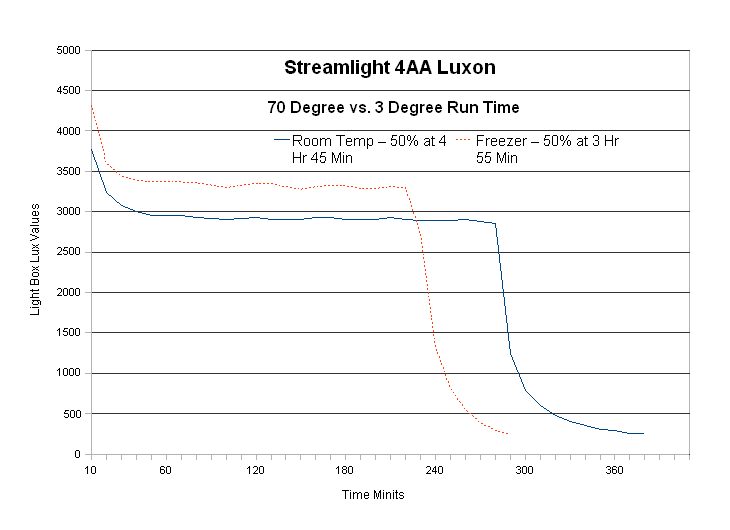Here is a Low Temp vs. Room Temp Runtime
We have had several threads about what type of batteries to use for low temperature operations. I did a system comparison light and batteries.
Streamlight 4AA Luxon 2000 MHr Eneloop Cells
Room Temp about 70 Degree F
Freezer Temp about 4 Degrees F
Meter Extech 401036 - Sample interval 10 min.
Light box milk carton similar to that at Flashlightreviews.com
I did one run at room temp. I then put 4 charged Eneloop cells and the Streamlight 4AA Luxon in the freezer ( the cells were separate from the light in a plastic bag to let them cool a bit faster ) initial soak time was a bit over 4 hours - I then put the cells in the light and and let it soak for another hour+++. The light box and light sensor were also soaked in the cold temp for about 4 hours. Light meter display was outside the freezer.
Results:
Freezer Run Time about 17% shorter
Freezer Light output about 15% higher
I hope this helps you with your battery & light selection.
mb

We have had several threads about what type of batteries to use for low temperature operations. I did a system comparison light and batteries.
Streamlight 4AA Luxon 2000 MHr Eneloop Cells
Room Temp about 70 Degree F
Freezer Temp about 4 Degrees F
Meter Extech 401036 - Sample interval 10 min.
Light box milk carton similar to that at Flashlightreviews.com
I did one run at room temp. I then put 4 charged Eneloop cells and the Streamlight 4AA Luxon in the freezer ( the cells were separate from the light in a plastic bag to let them cool a bit faster ) initial soak time was a bit over 4 hours - I then put the cells in the light and and let it soak for another hour+++. The light box and light sensor were also soaked in the cold temp for about 4 hours. Light meter display was outside the freezer.
Results:
Freezer Run Time about 17% shorter
Freezer Light output about 15% higher
I hope this helps you with your battery & light selection.
mb



